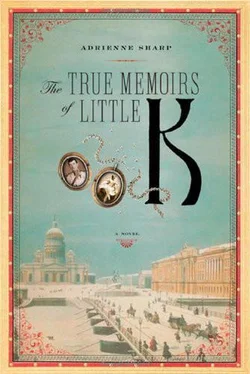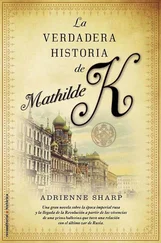And that was how Sergei came back to me, out of pity and obligation, and perhaps love, though whether for me or for Niki, I could not fully tell. He would not marry Countess Vorontzov-Dashkov, currently pregnant with his child. Unlike Niki, he could not love two women at once. Or two sons. It was my son, not his own, to whom Sergei would give his attention. And I was not sorry for the countess, did you think I would be?, only grateful that my son, at age three, finally had a father.
And, of course, I had once again a man in my bed, smelling of leather and oranges and horses, and I had missed Sergei. The tsar had his Alix, so why should I be alone?
_______
Yes, the fall of 1905 brought compromises for us all. Nicholas, who had wanted to appoint a military dictator and use martial law to crush the last of the disturbances, instead gave in and granted reforms. With the October Manifesto, written up by his ministers, the tsar managed to retain his throne by agreeing reluctantly to freedom of speech and assembly, to amnesty for all strikers, to a cabinet and a Duma—a parliament, in effect, of elected officials, which he resolved to dissolve as soon as he could.
So for now there was the Duma with its Social Democrats, a tiny number of them Bolsheviks and the majority Mensheviks, with its Constitutional Democrats, its Jewish Bundists, its Ukrainians, Poles, and Tartars—the Duma for which Alix would always blame Grand Duke Nicholas Nikolaevich, Niki’s uncle, who commanded the St. Petersburg military district and had refused to be Russia’s military dictator, the fist of the tsar, saying the time for repression had long passed. The Duma now sat in the Tauride Palace, a palace built by Catherine the Great in 1780 for her lover, Prince Grigory Potemkin, in gratitude for his having conquered the Crimea. What would she say to see the Duma in that palace now? The Tauride stood in Shpalernaya Street, out of sight of the Winter Palace, where the Neva wended its way in a great sandy shoehorn around the eastern part of the city. Out of sight, yes, but it was still there, desecrated by the men of the Duma, who stank of the animals they so recently tended, that smell so woven into the fibers of their clothes it could never be scoured out, by men who sucked in vodka and beer and spit out the husks of sunflower seeds sodden with it, until the corridors of the palace, eighteenth-century pictures hanging serenely from long wires, reeked of the peasantry.
Yes, there was a Duma, but Niki was still tsar, still commander of the army and the navy. He alone could declare war or make peace, and he alone could dissolve the Duma at will and make laws by emergency decree, and none of its laws could take effect until the tsar gave his approval, along with that of the State Council, the upper house of the Duma filled with nobles who ensured that no law counter to their interests ever passed. And so there was a Duma, but it had, as you can see, little power, which meant, as Sergei assured me, that little would change. But the Duma, by its very existence, meant, despite Sergei’s assertions, that there had been change—there was now open and legitimized opposition to the regime, and I knew from what happened in my theater that the opposition could be reprimanded, threatened, strangled, but it would eventually have its way. Look at how I always got mine! And so though Niki could dissolve the Duma, as he did seventy-two days after the opening ceremony, hating even the appearance that it could inhibit him as autocrat, by law it had to be reconstituted. You see, the Tauride faced the St. Petersburg Main Waterworks, a big redbrick building where the city’s water ebbed and flowed, forced through various pipes and valves and winches and pools and dams and into drains at will, and so Niki tried to control the will of the Duma—and of the country.
Sometimes, I imagined Niki, burdened with Alix, his fragile son, his roiling country, taking his solitary walks through the palace park from the yellow Alexander Palace to the blue, white, and gold Catherine Palace, its baroque grandeur evoking for him that time when a tsar ruled supreme, giving him strength to go on. Did he walk alone into the Great Hall, walk along its high windows and polished mirrors? I wished I could walk beside his reflection there and slip my little hand in his for comfort, whisper, You will prevail .
When the country quieted, so did the theater. Everyone who had opposed the regime and who had formed unions and committees and who had written up resolutions and had otherwise run about stirring up trouble was required to swear fealty once again to the tsar in writing before being granted amnesty as part of the larger general amnesty being offered to all in Russia who had taken part in strikes and protests. Dancers are not workers from the streets and they were easily intimidated. Most signed immediately. Fokine, Pavlova, Karsavina, and my brother, though, all refused to sign the loyalty oath, and when Josef slapped the face of a dancer who had signed and who Josef felt was a particular traitor, Josef was dismissed from the theater, and his wife, the princess, divorced him. Ironical, no, that it would be my imperial connections that saved his pension, my connections that would quietly find him a position with the court in charge of the tsar’s hunting lodges—far from the stage, it’s true, but the salary kept him alive. It was eight years, though, before I could arrange to have him reinstated at the theater, that’s how deep the feelings ran over these matters. Sergei Legat, the brother of my beautiful partner Kolinka, signed the declaration and then, feeling himself a traitor who had betrayed his friends, sliced his throat open with a razor. There were other consequences—two of the dancers who led the strikes were dismissed along with my brother; another was sent to a psychiatric hospital; others were not promoted, were given poor roles, went abroad to dance, to Berlin, to London, to Paris. These disasters, like the hangings and rapes and deportations that subdued the peasants and intellectuals, subdued the dancers, though there was, for several months, resentment between the two factions, between the dancers who, like me, were regime loyalists and those who had acted against it. The simmering resentment would eventually lead to a bleeding of talent from the tsar’s stages.
It was just a few years later, in 1909, that Fokine, along with Diaghilev and Benois and Bakst—the three free artists who had come to the theater—obtained the tsar’s permission to prepare a season of Russian exports to take to Paris. They would present some of the tsar’s greatest singers and dancers abroad, mounting a few operas mixed in with a few scènes des ballets .
Of these men, Diaghilev I loved the best. We called him Chinchilla because of the white streak that lay at the front of his hair on the right side and because his little white teeth looked exactly like those of a small animal. As a member of the theater staff—though briefly tenured, for he was dismissed within a few years after a dispute with Volkonsky—he came to all the performances at the Maryinsky, and though he prized music first and art second, he soon developed a great enthusiasm for the ballet. The dancers would sing under their breath whenever he arrived at the theater and took his seat in the administration’s box:
Ya tolko shto uznal,
Shto u nevo v korobkye shinshillah.
Ya ochen boyus oshibitsya!
I’ve just heard
That Chinchilla is in his box
And I’m terribly afraid to make a mistake!
Fokine I liked less. Why, he complained when I wore a tutu to rehearsal instead of the regulation practice clothes, as if I should be bound by some regulation. And when I had my maid bring Vova to a rehearsal, which I interrupted when Vova called for a kiss, Fokine erupted in rage. But what child does not deserve a kiss? We were only rehearsing Fokine’s ballet Le Pavilon d’Armide , a pale copy of a ballet Petipa could have done three times better. As for Pavlova—why, she wasn’t happy until she had the whole stage to herself, as she did in that mawkish solo The Dying Swan Fokine later made for her to that sugary music by Saint-Saëns, a solo she danced over and over again all around the world—even in Japan and India and South America to brown men with bones in their noses. Can you imagine? You’ve heard the legend of her death, the way she called for her swan costume to be brought to her and laid across her body, a pall of white feathers and gauze, a woman of the theater even to her last moment, mindful of the great story it would make from beyond the grave.
Читать дальше












